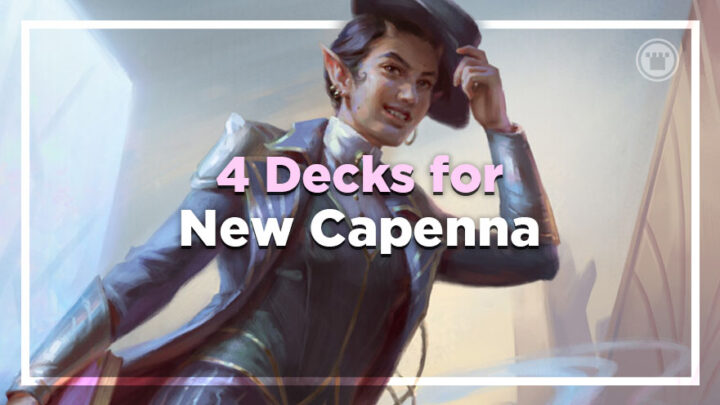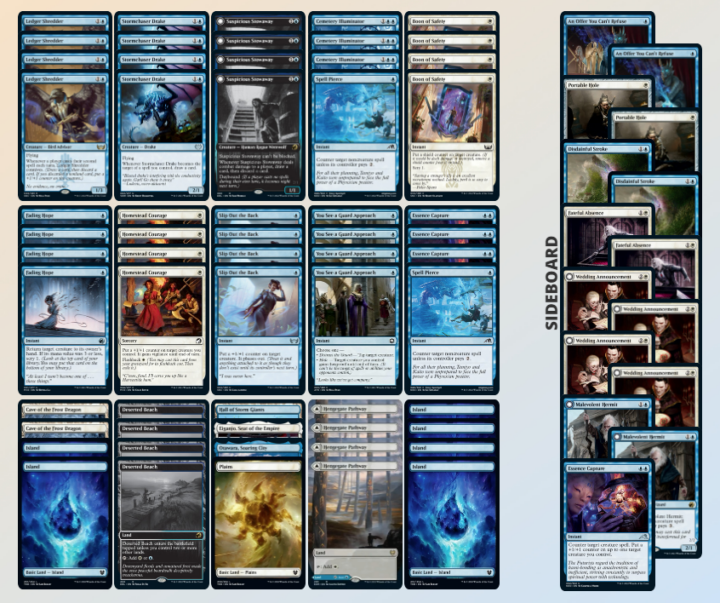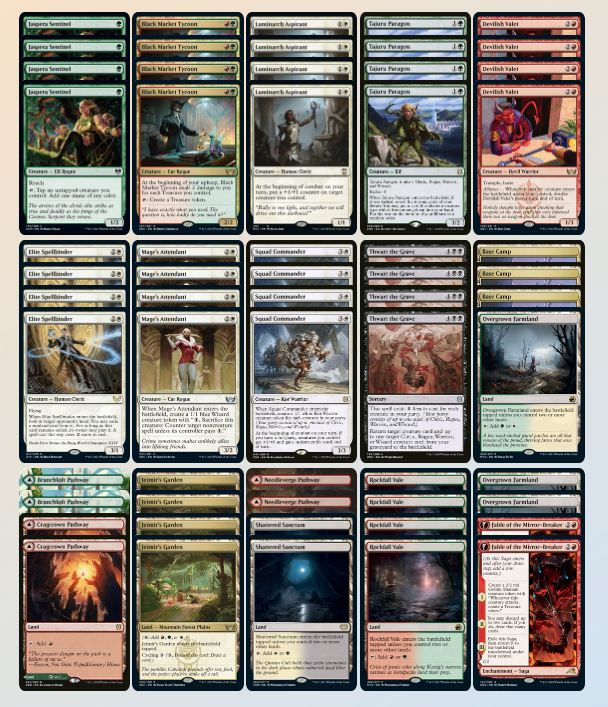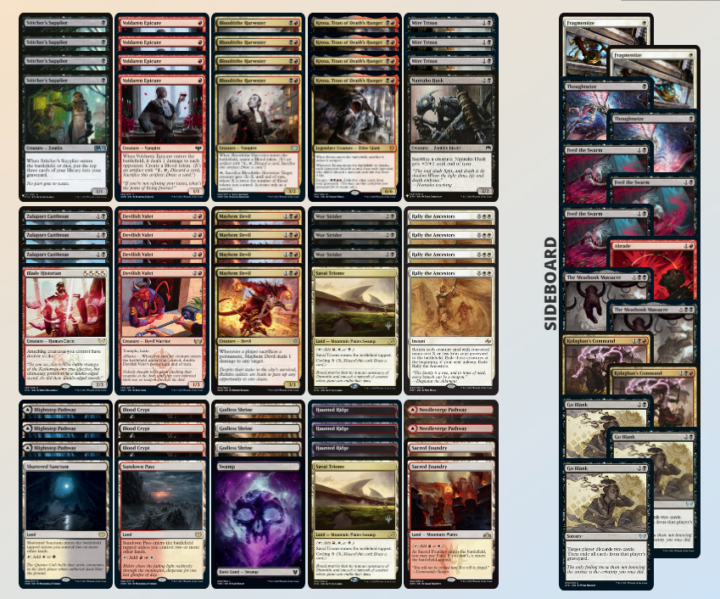Here we are: the release of New Capenna. A set full of unique tools. Today, we are going to cover a deck in each of the main paper format along with a bonus Standard deck. Lets not waste any time and jump into the deck lists!
UW Heroic
Standard this late into its life often needs one of two things to have new decks start to show up in meaningful ways. The first is some sort of new powerful late game or the support of an archetype that was under supported before. The latter is our first deck today. Essentially, we have a deck full of evasive creatures that looks to protect them while minimally disrupting the opponent along the way.
While this deck would love a card like Curious Obsession, it does have Stormchaser Drake as a way to meet in the middle. Stormchaser Drake really looks to abuse this deck’s synergies more then any other. If your opponent is going to try and answer this card, you have twelve protection spells and four copies of Fading Hope if you’re light on threats. When combined with its text, it becomes a card that is almost too risky to actually attempt to remove from play.
The cards from Streets of New Capenna that help enable this best are Slip Out the Back and Boon of Safety. Both of these protection spells have a unique twist to them that cards like Gods Willing does not. They actually save your creature from a wrath effect. This is a game-changing way to have your protection spells play out.
Now, this build is all-in on trying to protect a few cards and go the distance. You could look into Izzet builds of this deck that have more answers for what your opponents is doing, but we are looking to just abuse cheap spells and cheap threats to take over the game.
Standard Valet
Above, I mentioned how you need something new in the late game to really break into Standard. This deck looks to do that with a card from New Capenna. Devilish Valet is one of the cards we talked about in my last article. The quick version is this: Devilish Valet can get very large, very quickly so we are looking to play a deck that plays a medium beatdown plan with a combo finish. If we have four other creatures enter play in one turn, our Valet does sixteen damage, often enough to win. And it will do 32 damage with just one more creature in play that turn.
Have we finally reached critical mass with the party mechanic? It would appear so when quickly looking over the deck. The best pay off for this being Thwart the Grave, which doubles as a combo enabler for our Valet as just a value play. Your deck is very much a sum of your parts deck, but thanks to Thwart the Grave and Standard’s typical grinding, its not unfeasible to cast this card for five mana.
You might be looking at the mana for this deck and get an instant headache about how it will all work. I think that another New Capenna card secretly helps tie the whole room together. Black Market Tycoon. The Tycoon typically plays out just like a Paradise Druid, but if your willing to take a little damage you can save your mana to help deploy all at once. Not only does this help with making our mana smooth, it also enables us to have more burst turns.
This deck might be a little to flimsy, but it will take some time playing and tuning it to the metagame before we know for sure as the core plan is very powerful.
Pioneer Valet
Rally the Ancestors is one of the few broken Standard decks that didn’t instantly crack into Pioneer. Part of this is the high level of proactive decks in the format and better interaction and graveyard hate. Another big factor was that the payoff just wasn’t good enough. Sure you could bring all this stuff back, but it just didn’t quite win the game. Insert our Devilish Valet. As we established, bringing back five creatures is a win with this card, or four creatures with two copies of Devilish Valet, assuming your opponent can’t kill the devil.
This makes it so you actually have eight pieces of a combo win. You have the classic Woe Strider and Nantuko Husk combo, with cards like Zulaport Cutthroat and Mayhem Devil to ping the opponent out, and Devilish Valet to give you some fair play.
Speaking of fair plays cards, Kroxa, Titan of Death’s Hunger might seem counterintuitive, but I think they serve a duel role. First, they are a way to turn a rally into a value/burn play. Since you can bring back the Kroxas and they will sacrifice themselves, you can essentially clean your opponents hand up or do a burst of damage if they are low on cards in hand. This also combos nicely with Zulaport Cutthroat, allowing you to play a more fair game. Also, if your opponents have a deck heavy on counter spells and spot removal, Kroxa is a way to slowly work through all the permission. Bringing Kroxa back multiple turns in a row will force the opponent to start ending the game quickly or to have an exile-based answer.
It might seem like a lot of similar problems exist, but ultimately this gives you the ability to actually kill the opponent in more normal games and start to invalidate the typical angles of attack this deck would suffer from.
Modern Druid Gruul
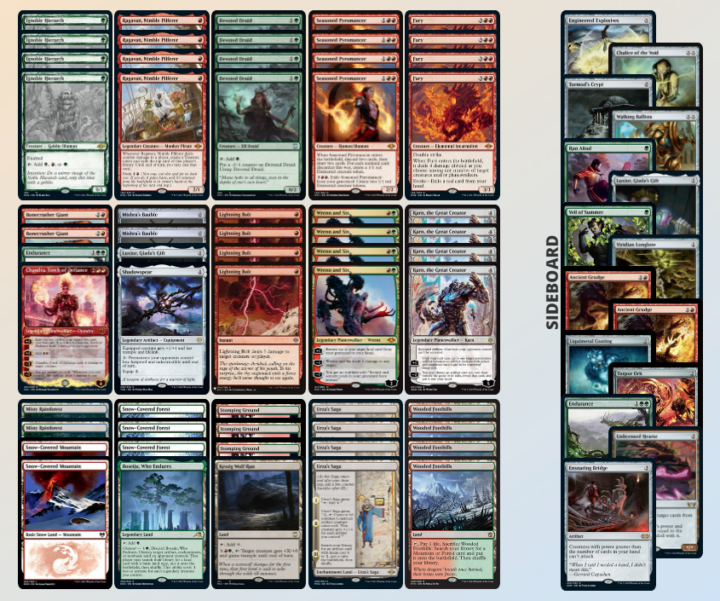
You probably didn’t expect to see the Gruul Druid deck in this article when you saw the Devoted Druid combo.
When the combo was first found with Luxior, Giada’s Gift and Devoted Druid, I wasn’t that excited. The traditional Druid combo deck has the problem that you can easily break it up with removal. Since it last saw serious Modern play, Solitude, Fury, Unholy Heat, and Prismatic Ending have all joined Modern in a BIG way. So the idea of a combo based on having a creature stick around in play for a turn was not super appealing. Players quickly realized that we could play Urza’s Saga and Stoneforge Mystic to more easily tutor the combo and play a fair game plan more easily. This was quickly something I was wary of with the early builds. Players had all these abilities to grind but had no way to stop the opponent’s main plan. With no way to imped the opponent and your main plan still being Devoted Druid in all of this, I was ready to write off the deck. Then an idea was brought up: what if we played a fair deck that could combo.
This change in perspective lead me down a road of trying to figure out what can we do to make Devoted Druid a card we want in our deck and then threaten to combo the whole game when its out. This lead me to exploring the Gruul shell.
Gruul is a deck that has a good fair plan that can interact with a wide swath of the format but its free wins always came from Blood Moon. So instead of trying to lock out a small percent of the format, I added the combo. Druid not only threatens to win the game but it also allows us to jump ahead on mana and use that advantage against our opponents. This is a fairly big reason that the Gruul deck could have a good game against other fair decks. Combine that with Urza’s Saga’s grinding potential and Wrenn and Six providing a stream of constant value with Urza’s Saga, I think this is potentially a great direction to look at taking the Gruul deck and Druid as a whole. Exploring other fair applications of the combo is an area of Modern I am very interested in mining personally.
That’s going to do it for today’s deck list. What are you most excited to play? Tweet at @CardKingdom and @masoneclark and let us know!

Mason Clark is a grinder in every corner of the game who has played at the pro level and on the SCG Tour with Team Nova. Whether he’s competing in Standard, Historic or Modern, Mason plays with one goal in mind: to be a better player than he was the day before. Check out his podcast, Constructed Criticism, and catch his streams on Twitch.

